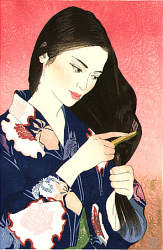Works by Paul Binnie or The Path to Japan
Paul Binnie - A Dialogue with the Past
To engage in the art of Paul Binnie is to walk between worlds, between the Japanese traditional art of color woodblock prints and the western notion of art, between real life and theatrical life, and between the past and the present.
The images on this page are link-sensitive and take you to other articles or web sites in which you might be interested.
Paul Binnie - Dialog with the Past
In order to present Binnie's first one hundred prints, editor Eric van den Ing of the 2007 Paul Binnie - A Dialogue with the Past did not highlight the context of cultural traditions of Japan in one fell swoop. The book is actually more of a monographic treatise, even if the essays therein concern the artist's life and the catalogue section dominates the book with high quality copies of Binnie's prints.
The Path to Japan
Paul Binnie was born in 1967 in Scotland, and he graduated from the University of Edinburgh with a degree in art history. He received a M.A. from the Edinburgh College of Art in 1990, by which time he was already showing interest in Japanese art. After his studies, he went to Paris where he taught and painted. In 1993 he followed his interests in the traditional Japanese color woodblock print to Tokyo. He stayed there for five and a half years, perfecting his technique and gaining experience.
Binnie's Fondness of the Theater
Scenes from Kabuki- and Noh-Theater were his preferred subject matters. Paul Binnie - A Dialogue with the Pastis full of portraits of actors from the theater. Akama Ryo, a philology professor at Ritsumeikan University in Kyoto and expert on traditional Japanese theater, analyzes these portraits, first in respect to interpreted role of each actor.
Facial expressions in traditional Japanese theater are instrumental when it comes to characterizing each figure. Binnie's tellingly engaging portraits are therefore not just representations in the normal sense, rather much more expressive homages to the masterful performances of the actors.
In his analysis and opinion, Akama Ryo labels Binnie's theater portraits as traditional Japanese, placing them among those that were cultivated in traditional color woodblock prints for centuries. Paul Griffith, who at the time of the publishing of this book is pursuing his doctorate in Japanese theater history, ties in Binnie's work with the western conception and examines the traditions of theatrical representation that Paul Binnie is able to gently introduce to contemporary art. More notedly in his paintings, however, which are in the beginning of the book.
Griffith himself worked in the Kabuki-Woodcut department of the Victoria and Albert Museum in London, which naturally has contributed to his extensive knowledge of painting and themes and offers several comparisons in his analysis of Binnie's theater paintings.
The Search for a Lost Past
The subject matter of the publication is however considerably broader. The Dialogue with the Past is above all an effort to incorporate lost values - like the beauty of subjects, formal traditional illustration and technical perfection of the color woodcut - in Binnie's work.
This all lies at the center of Paul Binnie's work, which is why art historians including Kendall H. Brown have placed his work in the category of traditional Japanese. The book examines the artist's life in detail, and follows his artistic development attentively, placing each in context to time and place.
Brown, however, also analyzes the technique and printing methods of Paul Binnie as well as their application in the development of traditional as well as contemporary motifs and subject matters. The collection features not only theater portraits but also architectural views and landscapes, plants, animals, feminine beauties, as well as many masculine nudes, many with tattooed bodies. Finally Binnie goes back to traditional famous woodcuts by the great masters, which he uses as models for his pieces.
The book Paul Binnie - A Dialogue with the Past, edited by Eric van den Ing with contributions by Kendall H. Brown, Paul Griffith and Akama Ryo was published in 2007 by Art Media Resources Chicago (USA), ISBN 978-1-58886-096-5.




















0 comments:
Post a Comment